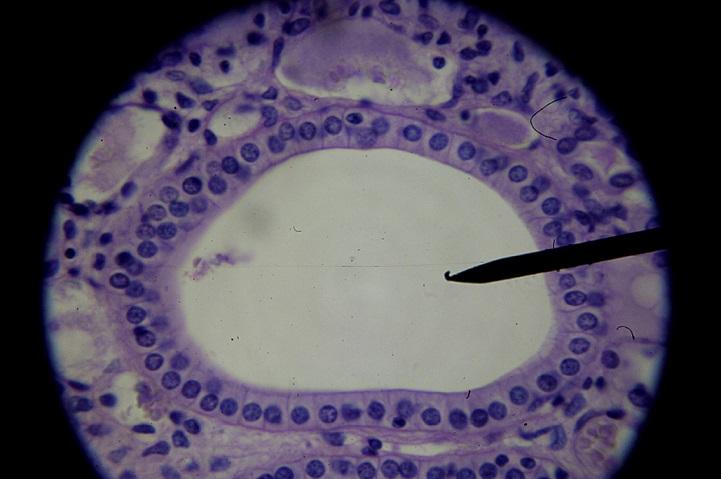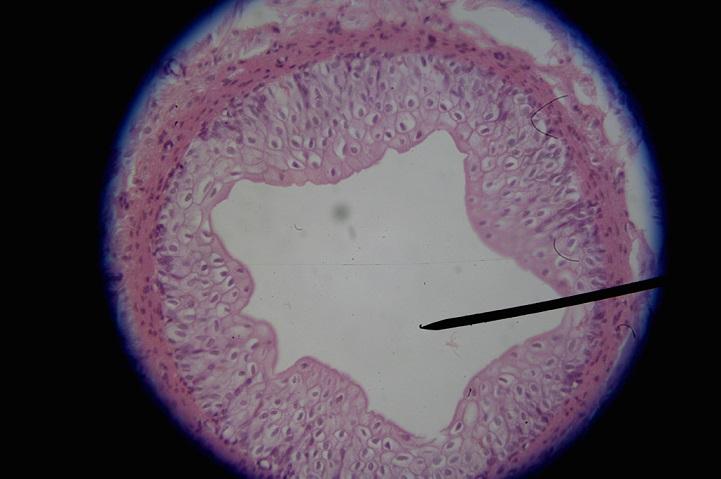Define tissues.
Groups of cells that are similar in structure and function.
What are the 4 main tissue types?
Epithelial, connective, nervous, and muscle.
Define organ.
Tissues that are organized to perform specific functions.
Define histology.
The study of tissues.
Define epithelial tissue.
A sheet of cells that covers a body surface or lines a body cavity.
Name 3 general functions of epithelial tissue.
1. Covering epithelium
2. Lining epithelium.
3. Glandular epithelium.
What are the 6 specific epithelial tissue functions?
1. Protection
2. Absorption
3. Filtration
4. Excretion
5. Secretion
6. Sensory Reception
What 5 special characteristics distinguish epithelial tissue from other types?
1. Polarity
2. Specialized contacts
3. Supported by connective tissue
4. Avascular but innervated
5. Regeneration
The covering and lining epithelia are classified according to what 2 criteria?
1. Number of layers
2. Cell Shape
Define simple epithelia.
One layer of cells attached to the basement membrane.
Define stratified epithelia.
Two or more layers of cells.
What are the 5 types of epithelial tissue based on shape?
1. Squamous
2. Cuboidal
3. Columnar
4. Pseudostratified
5. Transitional
How are stratified epithelia named specifically?
Named according to the cells at the apical surface of the epithelial sheet.
Where is transitional epithelium only found and why?
Urinary system organs that are prone to stretching.
Do epithelial tissue make up endocrine and exocrine glands?
Yes
2 differences of endocrine and exocrine glands.
1. Endocrine don't have ducts and exocrine do.
2. Endocrine glands secrete hormones into the blood, whereas exocrine glands secrete their products onto a body surface or into body cavities.
What are 4 common exocrine glands?
1. Sweat glands
2. Oil glands
3. Liver
4. Pancreas
Functions of simple squamous epithelium?
1. Diffusion of materials.
2. Filtration of materials.
3. Secretes lubricating substance in serosae. .
Locations of simple squamous epithelium?
1. Kidney glomeruli
2. Air sacs of lungs
3. Lining of heart
4. Blood vessels
5. Lymphatic vessels
6. Lining of ventral body cavity
Functions of simple cuboidal epithelium?
1. Secretion
2. Absorption
Locations of simple cuboidal epithelium?
1. Kidney tubules
2. Ducts of small glands
3. Secretory portions of small glands
4. Ovary surface
Functions of simple columnar epithelium?
1. Absorption
2. Secretion of mucus and enzymes.
3. Ciliated type propels mucus or reproductive cells.
Locations of nonciliated simple columnar epithelium and locations of ciliated simple columnar epithelium.
1. Digestive tract
2. Gallbladder
3. Excretory ducts of some glands
_______________
1. Small bronchi
2. Uterine tubes
3. Some regions of the uterus
Functions of pseudostratified columnar epithelium.
1. Secretes primarily mucus.
2. Ciliated type propels mucus.
Locations of nonciliated pseudostratified columnar epithelium and locations of ciliated pseudostratified columnar epithelium.
1. Sperm-carrying ducts
2. Ducts of large glands
__________________
1. Trachea
2. Most of upper respiratory tract
Function of stratified squamous epithelium?
Protects tissues subjected to abrasion.
Locations of nonkeratinized stratified squamous epithelium and location of keratinized stratified squamous epithelium.
1. Lining of the esophagus
2. Lining of the mouth
3. Lining of the vagina
_______
1. Epidermis of the skin
Function of stratified cuboidal epithelium?
Protection
Locations of stratified cuboidal epithelium?
1. Largest ducts of sweat glands
2. Mammary glands
3. Salivary glands
Functions of stratified columnar epithelium?
1. Protection
2. Secretion
Locations of stratified columnar epithelium?
1. Male urethra
2. Large ducts of some glands
Function of transitional epithelium?
Permits stretching of urinary organ by contained urine.
Locations of transitional epithelium?
1. Lining of ureters
2. Lining of bladder
3. Part of the urethra

1. Name the specific type of tissue.
2. Name the feature of the pointer.
1. Simple cuboidal epithelium.
2. Lumen

1. Name the specific type of tissue.
2. Name the feature of the pointer.
1. Pseudostratified ciliated columnar epithelium
2. Cilia

1. Name the specific type of tissue.
2. Name the feature of the pointer.
1. Pseudostratified ciliated columnar epithelium
2. Connective tissue

1. Name the specific type of tissue.
2. Name the feature of the pointer.
1. Transitional epithelium
2. Lumen

1. Name the specific type of tissue.
2. Name the feature of the pointer.
1. Simple columnar epithelium
2. Mucus secretion

1. Name the specific type of tissue.
2. Name the feature of the pointer.
1. Simple cuboidal
2. Simple cuboidal epithelial cell

1. Name the specific type of tissue.
2. Name the feature of the pointer.
1. Simple columnar epithelium
2. Basement membrane

1. Name the specific type of tissue.
2. Name the feature of the pointer.
1. Simple columnar epithelium

1. Name the specific type of tissue.
2. Name the numbers.
1. Pseudostratified ciliated columnar epithelium.
_____
1. Mucus of globlet cell
2. Cilia
3. Basement membrane
4. Pseudostratified epithelial layer

1. Name the specific type of tissue.
2. Name the numbers.
1. Simple columnar epithelium
_____
1. Mucus secretion
2. Microvilli
3. Goblet cell

1. Name the specific type of tissue.
2. Name the numbers.
1. Simple cuboidal epithelium
____
1. Simple cuboidal cell
2. Basement membrane
3. Lumen
4. Connective tissue

1. Name the specific type of tissue.
2. Name the numbers.
1. Simple squamous epithelium
2. Nuclei of squamous epithelial cell

1. Name the specific type of tissue.
2. Name the numbers.
1. Stratified cuboidal epithelium
_____
1. Basement membrane
2. Cuboidal epithelial cells
3. Duct lumen

1. Name the specific type of tissue.
2. Name the numbers.
1. Stratified squamous epithelium
____
1. Nuclei
2. Connective tissue
3. Basement membrane
4. Stratified squamous epithelium

1. Name the specific type of tissue.
2. Name the numbers.
1. Transitional epithelium
____
1. Transitional epithelial cells
2. Connective tissue
3. Basement membrane

1. Name the specific type of tissue.
2. Name the feature of the pointer.
1. Simple squmous epithelium.
2. Air sacs.